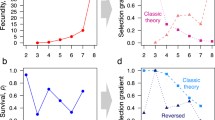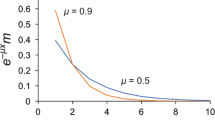Summary
I suggest that there may be a fundamental conceptual unity between two seemingly disparate phenomena: (1) senescence (the progressive deterioration in physiological function and, thus, individual fitness with age) and (2) niche conservatism (the observation that species often seem rather fixed over evolutionary time in their basic niche properties). I argue that both phenomena arise from demographic asymmetries. The evolutionary theory of ageing rests on the observation that the force of selection declines with age, reflecting the basic demographic facts that in persistent populations there are always fewer individuals in old than in young age classes and these individuals tend to have lower reproductive value. A similar demographic asymmetry arises when populations inhabit environments with source habitats (i.e. where conditions are within the species' niche) and sink habitats (where conditions lie outside the niche): there tend to be more individuals in sources than in sinks and individuals in sources have relatively higher reproductive values. These demographic asymmetries should often imply that the force of selection is greater in sources than in sinks, leading automatically towards niche conservatism. I suggest that niche evolution is most likely in circumstances where these demographic asymmetries in space weaken or reverse.
Similar content being viewed by others
References
Bell, M.A. (1988) Stickleback fishes: bridging the gap between population biology and paleobiology.Trends Ecol. Evol. 3 320–5.
Bradshaw, A.D. (1991) Genostasis and the limits to evolution.Phil. Trans. R. Soc. Lond. B 333 289–305.
Bradshaw, A.D. and McNeilly, T. (1991) Evolutionary response to global climate change.Ann. Bot. 67 (Suppl. 1), 5–14.
Brown, J.S. and Pavlovic. N.B. (1992) Evolution in heterogeneous environments: effect of migration on habitat specialization.Evol. Ecol. 6 360–82.
Caswell, H. (1989)Matrix Population Models. Sinauer Associates, Sunderland, Ma.
Charlesworth, B. (1993) Evolutionary mechanisms of senescence.Genetica 91 11–19.
Charnov, E.L. (1993)Life History Invariants: Some Explorations of Symmetry in Evolutionary Ecology. Oxford University Press, Oxford.
Coope, G.R. (1979) Late Cenozoic fossil Coleoptera: evolution, biogeography, and ecology.Ann. Rev. Ecol. Syst. 10 247–67.
Gomulkiewicz, R. and Holt, R.D. (In press) When does evolution by natural selection prevent extinction?Evolution.
Hamilton, W.D. (1966) The moulding of senescence by natural selection.J. Theor. Biol. 12 12–45.
Holt, R.D. (1985) Population dynamics in two-patch environments: some anomalous consequences of an optimal habitat distribution.Theor. Pop. Biol. 28 181–208.
Holt, R.D. (1987) Population dynamics and evolutionary processes: the manifold effects of habitat selection.Evol. Ecol. 1 331–47.
Holt, R.D. (1990) The microevolutionary consequences of climate change.Trends Ecol. Evol. 5 311–15.
Holt, R.D. (In press) Adaptive evolution in source-sink environments: direct and indirect effects of densitydependence on niche evolution.Oikos.
Holt, R.D. and Gaines, M.S. (1992) Analysis of adaptation in heterogeneous landscapes: implications for the evolution of fundamental niches.Evol. Ecol. 6 433–47.
Holt, R.D. and R. Gomulkiewicz. (ms.) Does immigration impede local adaptation? A re-examination of a familiar paradigm.
Houston, A.I. and McNamara, J.M. (1992) Phenotypic plasticity as a state-dependent life-history decision.Evol. Ecol. 6 243–53.
Huntley, B., Bartlein, P.J. and Prentice, I.C. (1989) Climatic control of the distribution and abundance of beech (Fagus L.) in Europe and North America.J. Biogeogr. 16 551–60.
Jaenike, J. (1993) Rapid evolution of host specificity in a parasitic nematode.Evol. Ecol. 7 103–8.
Kawecki, T.J. and Stearns, S.C. (1993) The evolution of life histories in spatially heterogeneous environments: optimal reaction norms revisited.Evol. Ecol. 7 155–74.
Kawecki, T.J. (1995) Demography of source-sink populations and the evolution of ecological niches.Evol. Ecol. 9 38–44.
Lewontin, R. (ed.) (1968)Population Biology and Evolution. Syracuse University Press, Syracuse, NY.
McPeek, M.A. and Holt, R.D. (1992) The evolution of dispersal in spatially and temporally varying environments.Am. Nat. 140 1010–27.
Mayr, E.R. (1963)Animal Species and Evolution. Harvard University Press, Cambridge, MA.
Pulliam, H.R. (1988) Sources, sinks, and population regulation.Am. Nat. 132 652–61.
Ricklefs, R.E. and Latham, R.E. (1992) Intercontinental correlation of geographical ranges suggests stasis in ecological traits of relict genera of temperate perennial herbs.Am. Nat. 139 1305–21.
Rose, M. (1991)Evolutionary Biology of Aging. Oxford University Press, Oxford.
Rosenzweig, M.L. (1987) Habitat selection as a source of biological diversity.Evol. Ecol. 1 315–30.
Shmida, A. and Ellner, S. (1984)Vegetatio Coexistence of plant species with similar niches.58129-55.
Travis, J. and Futuyma, D.J. (1993) Global change: lessons from evolutionary biology. InBiotic interactions and global change (Kareivaet al., eds) pp. 251–66. Sinauer Press, Sunderland, Ma.
Van Valen, L. (1967) Selection in natural populations. 7. New York babies (fetal life study).Ann. Hum. Genet. 31 109–27.
Author information
Authors and Affiliations
Rights and permissions
About this article
Cite this article
Holt, R.D. Demographic constraints in evolution: Towards unifying the evolutionary theories of senescence and niche conservatism. Evol Ecol 10, 1–11 (1996). https://doi.org/10.1007/BF01239342
Issue Date:
DOI: https://doi.org/10.1007/BF01239342




